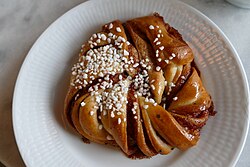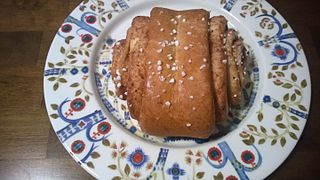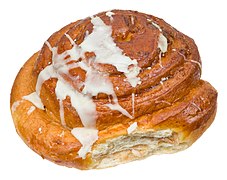Cinnamon Roll
A cinnamon roll (also known as cinnamon bun, cinnamon swirl, cinnamon Danish and cinnamon snail) is a sweet roll commonly served in Northern Europe (mainly in Nordic countries, but also in Austria and Germany) and North America.
In Sweden it is called kanelbulle, in Denmark it is known as kanelsnegl, in Norway it is known as kanelbolle, skillingsbolle, kanelsnurr, or kanel i svingene, in Finland it is known as korvapuusti, in Iceland it is known as kanilsnúður, and in Estonia it is known as kaneelirull. In Austria and Germany, it is called Zimtschnecke.
 A Swedish cinnamon bun or ”kanelbulle” with pearl sugar | |
| Alternative names | Cinnamon bun, cinnamon swirl, cinnamon Danish, cinnamon snail |
|---|---|
| Type | Sweet roll |
| Place of origin | |
| Region or state | Northern Europe |
| Main ingredients | Flour, cinnamon, sugar, and butter (or any other solid fat) |
Pastry
A cinnamon roll consists of a rolled sheet of yeast-leavened dough onto which a cinnamon and sugar mixture (and raisins or other ingredients in some cases) is sprinkled over a thin coat of butter. The dough is then rolled, cut into individual portions and baked. The deep fried version is cinnamon roll or cinnamon bun doughnut. Its main ingredients are flour, cinnamon, sugar, and butter, which provide a robust and sweet flavor.


Origins
Roman spice traders introduced the Sri Lankan cinnamon spice to Europe.
The spice later began to be used in Swedish pastries, with the modern kanelbulle (lit. ''cinnamon bun'') being created after the first world war. Since 1999, October 4 has been promoted as Cinnamon Roll Day (Kanelbullens dag), a national theme day, acknowledged by a significant portion of the Swedish population. Swedish kanelbulle dough typically also contains cardamom (powder or buds), giving it a distinctive flavour.
The size of a cinnamon roll varies from place to place, but many vendors supply a smaller size about 5 centimeters (2.0 in) in diameter and a larger size about 10 cm (3.9 in) to a side. The larger variety can be found in Finland, called korvapuusti (lit. 'a 'cuff on the ear'', fig. "pulling someone's ear for disciplining"), where it can be up to 20 cm (7.9 in) in diameter and weigh up to 200 g (7.1 oz).
Haga, a district in Gothenburg, Sweden, is well known for its very large cinnamon rolls. These cinnamon rolls are called hagabullar or Queen of the Kitchen. Hagabullar are usually 30 centimeters (12 in) or more in diameter and are, despite their size, not considered a communal roll.
National variations
The Swedish Butterkaka and Finnish bostonkakku ("Boston cake") is a cake made by baking cinnamon rolls in a round cake pan instead of baking them separately, so that they stick together to form a large, round cake.
A German variety, which closely follows the form of the Scandinavian pastry, originating in Hamburg and its surroundings is the Franzbrötchen, a cinnamon pastry inspired by the non-cinnamon French croissant.
American cinnamon rolls are frequently large, baked in a pan and topped with icing (usually confectioners' sugar-based) and are sometimes fried, finished with glaze, and served as a variation of a raised donut. There are also regional combinations: in the American Midwest, especially Nebraska and Kansas, cinnamon rolls are commonly eaten with chili.
In Canada, they are known as cinnamon buns. They are usually self-glazed and not iced, nor do they usually have raisins. They can have so much cinnamon that they are spicy and hot to the taste.
In Austria and Germany they are widely available at supermarkets and bakeries. Along with Topfengolatsche, Buttercroissant and Faschingskrapfen they are a typical pastry to have with afternoon coffee.
Cinnamon roll traditions
In Sweden and Finland, cinnamon rolls are traditionally enjoyed during a fika, which is a get-together, including consumption of coffee and or baked goods. A fika is typically had in the afternoon. By coworkers during a break, by friends or by family. National Cinnamon Bun Day (Kanelbullens dag) is observed on October 4 in Sweden and Finland.
In Denmark, cinnamon buns are especially popular on Wednesdays, where an extra large variant called the Wednesday snail is sold. This tradition was especially invented during the 1990s where the national football team usually played their games on Wednesdays.
In North America, it is commonly eaten for breakfast or dessert. When eaten for a breakfast in the U.S., it may be served with cream cheese frosting.
Gallery
- National variations
- Finnish korvapuusti
- Danish kanelsnegl
- Norwegian skillingsbolle
- American cinnamon roll
- Baking process
- Raw cinnamon rolls
- Ready to bake after proofing
- Partially baked rolls in a solar cooker
- Fully baked cinnamon rolls
See also


References
This article uses material from the Wikipedia English article Cinnamon roll, which is released under the Creative Commons Attribution-ShareAlike 3.0 license ("CC BY-SA 3.0"); additional terms may apply (view authors). Content is available under CC BY-SA 4.0 unless otherwise noted. Images, videos and audio are available under their respective licenses.
®Wikipedia is a registered trademark of the Wiki Foundation, Inc. Wiki English (DUHOCTRUNGQUOC.VN) is an independent company and has no affiliation with Wiki Foundation.










